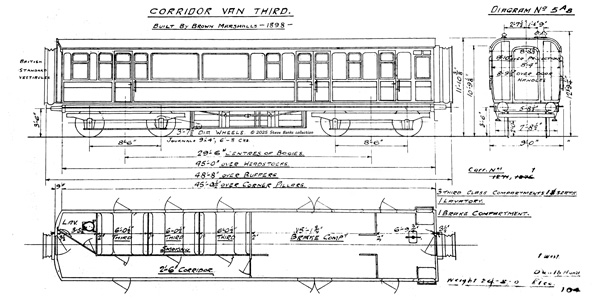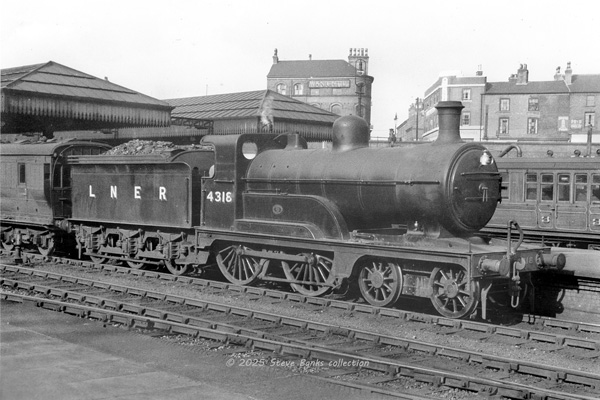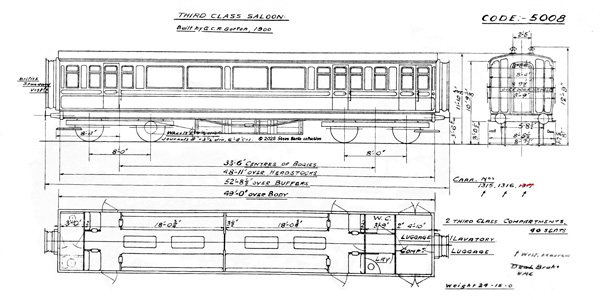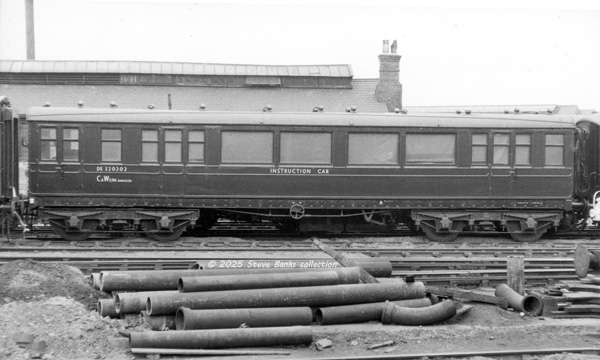GCR carriages - Parker style
The GCR as a company was controversial in its day but as has been noted elsewhere, not all modern historians have served it well and when it comes to carriage design, there is a lot of confusion, especially about stock built by the early GCR. There are two parts to the story:
1 - Thomas Parker Junior
1 - Thomas Parker Junior
was the Carriage and Wagon Superintendent responsible for the elegant designs of the 1890s - not "Pollitt" as stated in BR Pre-Nationalisation Coaching Stock, Hugh Longworth, 2018 (he was the Locomotive Engineer).
The Parker gangwayed carriages of 1898-99 were aimed at the soon-to-be-opened London Extension and were quite opulent and, apart from the clerestory catering carriages, had two body lengths:
- 46'6" for the normal carriages with bow ends, - 45'9" for the brake-ended ones which had a flat guard's end.
The roof had a flat-top, similar to the GNR Howlden roof, but with a more generous radius above the sides.
George Dow got this right in his GCR trilogy but an erroneous length of "45ft" has been quoted by many hands for these carriages, including model railway kit-makers and Hugh Longworth, who inconsistently states both the right and the wrong lengths.
3rd brake (BTK)
I start with this 1898 design from Parker because it shows all of his features:

His Diagram for the 3rd brake is actually one of three virtually identical ones: 5A6-5A8. Note the assymetrical ends: bow-ended facing inside the train but the guard's end, flat-ended. Hence the body length of 45'9" (which I have rounded from the actual 45'9½"). As far as I can tell there were no rear facing windows. That feature was introduced later in Robinson's designs. The second one built to this diagram, No 1000, was dual braked, vacuum and Westinghouse, for cross-country trains over the NER. The air brake was removed in the late 1920s.

I don't have a portrait of this design but can offer one in LNER service at Nottingham Victoria, although it's the far side to that shown in the diagram. The date is c.1929 judging by the loco details and it's interesting for two reasons:
- the lining is a blend of the GCR style below the waist with full lining around the curves but, above, GNR/LNER style confined to the verticals. I was under the impression that all the lining was omitted and that may have been a later simplification when these carriages went into secondary services but as this photo and the next one shows, they were lined at first.
- seen in the south facing bay at Nottingham Victoria from which GN-section trains departed for Grantham, this Parker carriage is twenty years old and it's been cascaded into secondary service and modernisation of much older ex-GNR carriages. If only we could see the rest of the formation! Mixtures like this were plentiful in secondary services but tend not to be "seen" by modellers. Photographer unknown, author's collection.
1st (FK)
I have some good illustrations because most of these early designs lasted into BR days. The Diagrams were:
Built |
Length |
GCR |
Numbers | |
------ |
--------- |
------- |
-------------- | |
1898 |
46'6" |
5Q1 |
1261 | |
1898 |
46'6" |
5Q2 |
1260/2-91 | |
------- |
------ |
------ |
------------------------- |
|
1906-7 |
50' |
5Q3 |
5468/71-2, 5974-5 | |
1907 |
50' |
5Q4 |
5481 | |
In 1938 the LNER introduced Hollerith Codes for the Diagrams and this led to the GCR Diagram numbers being removed and over-written, and promptly re-entered in pencil or biro!

Diagrams 5Q1 and 5Q2 were identical externally and I am showing the first one because the original is in better condition. It's a fine example of all the Parker concepts. First Class seating was 2-a-side with excellent leg room and despite being quite a short design with only five compartments, two lavatories were provided, one at each end, each with a WC and hand-basin. There was no end vestibule with an external door, a design feature which became something of a constant in GCR carriages right up to the Grouping.
Note the placement of windows on the corridor side in harmony with each compartment, something that Gresley designs didn't always manage. Diagram: Author's collection.
Livery - the Parker stock was painted brown & French grey, which began to be replaced from 1903 by brown & cream. In 1908 there was a switch to a varnished livery after which previously built stock was stripped, rubbed down and varnished. There is some debate as to whether the panelling of the painted carriages had employed mahogany (which takes paint well) rather than teak (which being more oily, does not). If mahogany had been used then the subsequently varnished livery would have stood out from the next generation of varnished teak carriages. A difference can sometimes be seen in b&w photographs and an observer from the 1930s commented on it to me but I have no further evidence myself.
Click on the image for an enlargement

This picture at an unknown time and place shows an example of the outwardly similar Diagram 5Q2 in LNER days and is seen from the corridor side. The variation in density of colour of the panels attests to the difficulty of rubbing down and varnishing wood that had previously been painted. Note the hybrid form of lining as described above. Photo: SLS.
Click on the image for an enlargement

Pollitt 11A Class 4-4-0 No 872 is near Northwood c1900 with an Up express made up with four Parker carriages. The third one is a 46'6" FK to Diagram 5Q1 or 5Q2. Photo: Author's collection.
Click on the image for an enlargement
They were a significant step forward and became the company's house style for a dozen years.
3rd Saloon (1900)
Parker's last designs in 1900 were for four types of bogie saloon, 1st and 3rd Class, and too wide a variety in length and style to dwell on (except to say that this was clearly a lucrative market) and that the last one featured:
- length increased to 49' - flat gangwayed ends - low elliptical roof.
Only three were built and the design is largely forgotten and that it was a stepping stone to future designs for nearly ten years.

This is the Diagram (originally 5F1) as revised with the lavatory at the left hand end taken out. The basis for Robinson's Parker-style designs from 1903 can be seen. Diagram author's collection.
Click on the image for an enlargement

They had quite a long life of 54 years in passenger service until 1953, No 1316 then being converted into a C&W Instruction Car based at Doncaster for the E/NE Regions and living on until at least 1959 as DE320202, seen here at Doncaster Works on 30th May 1959 after a recent overhaul. Photo RS Carpenter. It is wrongly shown in Longworth's book as a "Pollitt" design. Sorry to keep flagging up this man's errors but they are so numerous that a corrected reprint is not likely for there is too much to undo with fake Diagrams and descriptions.
Click on the image for an enlargement
2 - Robinson's Parker-style from 1903-08
After Robinson took over carriage design in 1902, he maintained the company's house style established by Parker and refined in 1900. Robinson's first designs followed in 1903 (not "1906" as stated in J.G. Robinson's, A Lifetime's Work, David Jackson, 1996). He merely increased the carriage length by a foot to 50' and added a turn-under to the flat ends. Gresley, on the GNR, was to retain bow ends, but he began to extend his gangwayed carriages to 52'6" and 58'6". Robinson's last designs in the Parker style were in 1906-8 for 60' auto-carriages and a 12w TO(dining). Hence there were two successive periods from 1898-1909 when the Parker style dominated the gangwayed expresses - under Parker and then under Robinson.
The next era would begin in 1910 - and retain a length of 60' but with a radical change to matchboard panelling, which is covered separately.
1st (FK)

This is the Parker concept as developed by Robinson to Diagram 5Q3 and not entirely favourably. The house style was maintained in terms of the overall look and it can take a direct comparison between the Diagrams to see the slight differences. Sliding doors were introduced internally but the leg room was reduced by three inches to 6'11". How well the new norm was received is hard to say and it wasn't until the significantly longer matchboard stock came in where 7'2" was restored.
Another problem was a shortage of space for the lavatories and the available space was reduced so much - from 4'6" to 3'6" - that the facilities had to be divided with a separate water closet (W.C.) at one end and a wash basin ("Lavatory") at the other end. This was unhygenica and a backward step, especially in a 1st Class carriage. Robinson could usefully have added a few more feet to the design. Diagram: Author's collection.
The lavatorial shortcoming was eventually recognised in the FK after five had been built (perhaps after passengers complained?) and in the final carriage, proper lavatories with WC and washbasin were provided at both ends. It really was a squeeze, though, and if you tried spreading your arms you'd find that there wasn't enough space! This final carriage was given Diagram 5Q4.
Click on the image for an enlargement

The same Diagram seen at Harlow on July 1955 is E5472E from the compartment side. The livery may be plain brown. Side doors to every compartment were to be a staple on Britain's railways for a long time and inevitably looked more utilitarian and less glamorous than the corridor side. Nevertheless, the pocket size of all-1st carriages like these gave them a long life and as this picture shows, many lasted well into BR days, the last one not being withdrawn until 1956. Such stock was often retained in excursion traffic whether for 1st or lower Class passengers. Photo: Lens of Sutton.
Click on the image for an enlargement

In another scene near Northwood a few years later which can be dated to on or after 1903 and a heavier Up express, possibly from Manchester, is approaching with a tidy 5-set with a restaurant car and a 6w strengthener on the rear. From this angle it is hard to distinguish between types and as far as I can tell, there is a 45'9"1st Class brake behind the tender while the second carriage may be a 46'6" TK or a 50' FK to Diagram 5Q3 or 5Q4. Then comes the 3rd restaurant. Photo: Author's collection.
Click on the image for an enlargement
To be continued...
Related topics:
GCR carriages - 50ft London Suburban: are here.
GCR Barnum carriages: are here.
GCR London Extension - expresses: are here.


